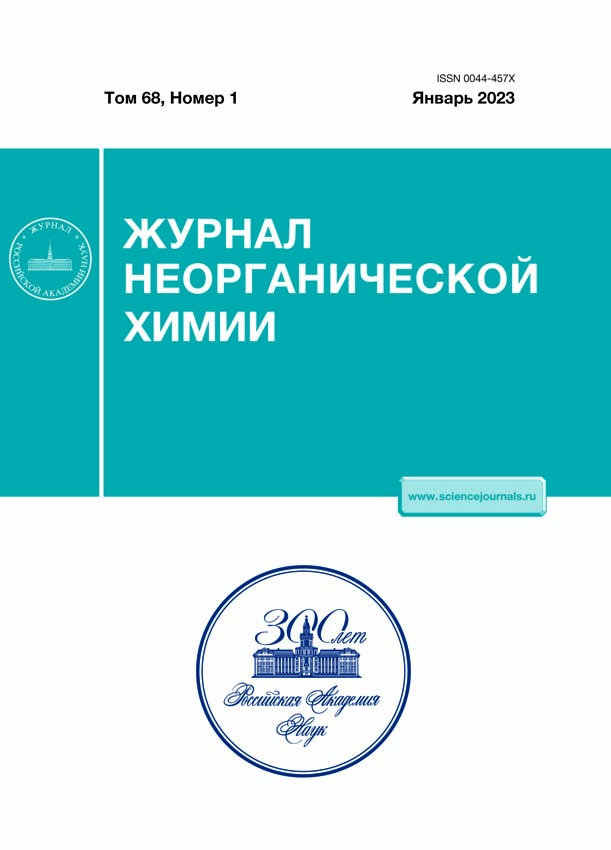Preparation of NASICON Na3Zr2Si2PO12 by Pyrolysis of Organic Solutions: Features of Phase Formation
- Authors: Grishchenko D.N.1, Kuryavyi V.G.1, Podgorbunsky A.B.1, Medkov M.A.1
-
Affiliations:
- Institute of Chemistry, Far Eastern Branch, Russian Academy of Sciences
- Issue: Vol 68, No 1 (2023)
- Pages: 17-25
- Section: СИНТЕЗ И СВОЙСТВА НЕОРГАНИЧЕСКИХ СОЕДИНЕНИЙ
- URL: https://rjraap.com/0044-457X/article/view/665319
- DOI: https://doi.org/10.31857/S0044457X22601043
- EDN: https://elibrary.ru/GVETOJ
- ID: 665319
Cite item
Abstract
A new promising method for the synthesis of NASICON (Na3Zr2Si2PO12) by pyrolysis of organic solutions has been developed. Sodium oleate, zirconyl oleate, tributyl phosphate, and tetraethoxysilane have been used as precursors. The molar ratios of the components of the mixture for the formation of NASICON have been established. The effect of sodium on the formation of the zirconium dioxide phase has been proven. A finely dispersed material with an average grain size of 0.2 µm has been obtained. Changes in morphology and composition depending on the time and temperature of firing the sample are studied. The results have been confirmed by X-ray powder diffraction and scanning electron microscopy. To refine the parameters of the crystal lattice, a full-profile analysis has been performed by the Rietveld method. The process of obtaining NASICON takes about 9 h, i.e. it is the least time consuming of all the alternative ways of synthesis. The advantages of this method are the possibility of lowering the sintering temperature, the absence of the need to control many parameters during synthesis, and minimizing the duration and multi-stage process. The method contributes to the development and production of more promising ion-substituted structures.
About the authors
D. N. Grishchenko
Institute of Chemistry, Far Eastern Branch, Russian Academy of Sciences
Email: grishchenko@ich.dvo.ru
690022, Vladivostok, Russia
V. G. Kuryavyi
Institute of Chemistry, Far Eastern Branch, Russian Academy of Sciences
Email: grishchenko@ich.dvo.ru
690022, Vladivostok, Russia
A. B. Podgorbunsky
Institute of Chemistry, Far Eastern Branch, Russian Academy of Sciences
Email: grishchenko@ich.dvo.ru
690022, Vladivostok, Russia
M. A. Medkov
Institute of Chemistry, Far Eastern Branch, Russian Academy of Sciences
Author for correspondence.
Email: grishchenko@ich.dvo.ru
690022, Vladivostok, Russia
References
- Wang H., Zhao G., Wang S. et al. // Nanoscale. 2022. V. 14. № 3. P. 823. https://doi.org/10.1039/d1nr06959d
- Rao Y.B., Bharathi K.K., Patro L.N. // Solid State Ionics. 2021. V. 366–377. P. 115671. https://doi.org/10.1016/j.ssi.2021.115671
- Майоров П.А., Асабина Е.А., Петьков В.И. и др. // Журн. неорган. химии. 2020. Т. 65. № 5. С. 660. https://doi.org/10.31857/S0044457X2005013X
- Kim H.J., Choi J.W., Kim S.D., Yoo K.S. // Mater. Sci. Forum. 2007. V. 544–545. P. 925. https://doi.org/10.4028/www.scientific.net/MSF.544-545.925
- Tetsuya K., Miyachi Y., Shimanoe K., Yamazoe N. // Sens. Actuators, B: Chem. 2001. V. 80. № 1. P. 28. https://doi.org/10.1016/S0925-4005(01)00878-4
- Paściak G., Mielcarek W., Prociów K., Warycha J. // Ceram. Int., Part. B. 2014. V. 40. № 8. P. 12783. https://doi.org/10.1016/j.ceramint.2014.04.132
- Jalalian-Khakshour A., Phillips Ch., Jackson L. et al. // J. Mater. Sci. 2020. V. 55. P. 2291. https://doi.org/10.1007/s10853-019-04162-8
- Naqash S., Sebold D., Tietz F., Guillon O. // J. Am. Ceram. Soc. 2019. V. 102. № 3. P. 1057. https://doi.org/10.1111/jace.15988
- Yang G., Zhai Y., Yao J. et al. // Chem. Commun. 2021. V. 57. P. 4023. https://doi.org/10.1039/d0cc07261c
- Zhang S., Quan B., Zhiyong Z., Zhao B. // Mater. Lett. 2004. V. 58. № 1. P. 226. https://doi.org/10.1016/S0167-577X(03)00450-6
- Porkodi P., Yegnaraman V., Kamaraj P. et al. // Chem. Mater. 2008. V. 20. № 20. P. 6410. https://doi.org/10.1021/cm800208k
- Shimizu Y., Azuma Y., Michishita S. // J. Mater. Chem. 1997. V. 7. P. 1487.
- Zhou M. // Sens. Actuators, B: Chem. 2007. V. 122. № 2. P. 419. https://doi.org/10.1016/j.snb.2006.06.011
- Ignaszak A., Pasierb P., Gajerski R., Komornicki S. // Thermochim. Acta. 2005. V. 426. № 1–2. P. 7. https://doi.org/10.1016/j.tca.2004.07.002
- Fuentes R.O., Figueiredo F., Soares M.R., Marques F.-M.B. // J. Eur. Ceram. Soc. 2005. V. 25. № 4. P. 455. https://doi.org/10.1016/j.jeurceramsoc.2004.02.019
- Fuentes R.O., Marques F.M.B., Franco J.I. // Bol. Soc. Esp. Cerám. Vidrio. 1999. V. 38. № 6. P. 631.
- Fuentes R.O., Figueiredo F., Marques F.-M.B., Franco J.I. // Solid State Ionics. 2001. V. 139. № 3–4. P. 309. https://doi.org/10.1016/S0167-2738(01)00683-X
- Narayanan S., Reid S., Butler S., Thangadurai V. // Solid State Ionics. 2019. V. 331. P. 22. https://doi.org/10.1016/j.ssi.2018.12.003
- Naqash S., Ma Q., Tietz F., Guillon O. //Solid State Ionics. 2017. V. 302. P. 83. https://doi.org/10.1016/j.ssi.2016.11.004
- Oh J.A.S., He L., Plewa A. et al. // ACS Appl. Mater. Interfaces. 2019. V. 11. № 43. P. 40125. https://doi.org/10.1021/acsami.9b14986
- Fuentes R.O., Figueiredo F.M., Marques F.M.B., Franco J.I. // Solid State Ionics. 2001. V. 140. № 1–2. P. 173. https://doi.org/10.1016/S0167-2738(01)00701-9
- Lee J.S., Chang C.M., Lee Y.I. et al. // J. Am. Ceram. Soc. 2004. V. 87. № 2. P. 305. https://doi.org/10.1111/j.1551-2916.2004.00305.x
Supplementary files

















